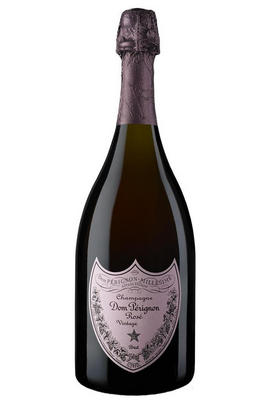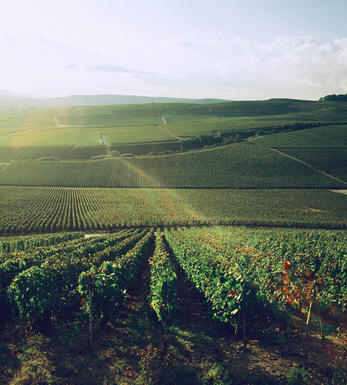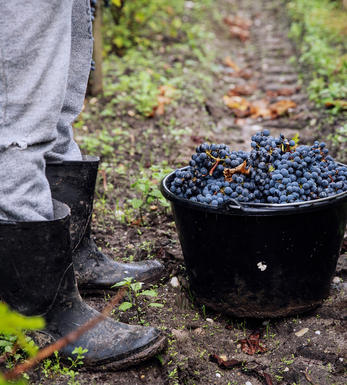
2002 Champagne Dom Pérignon, Rosé, Brut

Critics reviews
As it often is, this is quite aromatically discreet with its elegant and beautifully layered blend of soft yeast, cherry, raspberry, apple and rose petal. The still tightly coiled, intense and beautifully textured medium weight flavors possess an extremely fine effervescence before terminating in a clean, delineated and sneaky long finish that is markedly dry but not really austere. While the 750 ml version is drinking perfectly well now, in magnum format this striking beauty could still benefit from a few more years of keeping.
Drink from 2027 onward
Allen Meadows, Burghound.com (October 2020)
The 2002 Dom Pérignon Rosé is a tremendous example of this vintage at its very best. A Champagne of vertical thrust and intensity, the 2002 is rich, opulent and hedonistic from the very first taste. Readers should expect a Rosé built on a huge core of fruit. Rose petal, passion fruit and exotic flowers add shades of dimension to the wine’s decidedly flamboyant personality. What a wine!
Drink 2019 - 2052
Antonio Galloni, Vinous.com (July 2019)
The 2002 Dom Perignon Rosé is deep and chewy yet amazingly refined. The Dom Perignon Rosé is still very taut and shut down, hinting at yet more complexity and fun to come with proper cellaring.
Drink 2018 - 2042
Ian D'Agata, Vinous.com (March 2018)
Bright orange-pink. A heady, intensely perfumed bouquet evokes candied red berries, blood orange, rose oil and buttered toast, with vibrant mineral and Asian spice nuances adding complexity; smells like a high-class red Burgundy from one of the high-rent Chambolle neighborhoods. Sappy, penetrating raspberry and bitter cherry flavors gain sweetness with air, with notes of orange marmalade and succulent herbs adding complexity. Clings with superb intensity on the smoky, minerally, floral finish.
Josh Raynolds, Vinous.com (November 2013)
Magnum. Pungent and composed with massive energy. Lovely edge of freshness. Long and nuanced. So clean and pure. Long and lovely!
Drink 2015 - 2028
Jancis Robinson MW, JancisRobinson.com (December 2018)
This is an incredible rosé with super fine tannins that are layered and caress the palate, giving this Champagne an incredible mouthfeel. Iron and stone in the nose. Iodine. Dried flowers as well as dried strawberries and peaches. It's full-bodied but not overpowering and shows super complexity. Chalky sensation as well. A truly great wine for the table. You sip and fall in love. Aged all this time in the cellar of Dom Perignon.
Drink or hold
James Suckling, JamesSuckling.com (August 2023)
About this WINE

Dom Perignon
Dom Pérignon was the 17th century Benedictine monk who has gone down in history as the person who "invented" Champagne. His name was originally registered by Eugène Mercier. He sold the brand name to Moët & Chandon, which used it as the name for its prestige cuvée, which was first released in 1937.
A rigorous selection process in both the vineyard and winery ensures that only the best grapes go into Dom Pérignon champagne. Chardonnay and Pinot Noir are used in roughly equal proportions without one variety dominating the other.
In its youth, Dom Pérignon shows incredibly smooth, creamy fruit with perfect balance and weight. As it ages, it takes on wonderfully toasty aromas and a finesse equalled by very few of the other Grandes Marques.
Since 2014 Dom Pérignon has no longer been using the term oenothèque for its late-release Champagnes, but the word Plenitude. This style represents Dom Pérignon champagne that is left in contact with its lees and does not evolve in a linear fashion, but ages in a series of stages, producing “windows of opportunity, or plenitudes” when the Champagne can be disgorged and released to bring consumers a different expression of the same vintage.
There are three plenitudes in the life of a given vintage: the first plenitude spans between seven to eight years after the vintage, which is when Dom Pérignon Vintage is released, while the second one arrives between 12 and 15 years – which was previously the first oenothèque release, but from now will be branded as P2. The third window comes after around 30 years, when the Champagne has spent more than 20 years on its lees, which will now be termed as P3.

Rosé Champagne
Rosé wines are produced by leaving the juice of red grapes to macerate on their skins for a brief time to extract pigments (natural colourings). However, Rosé Champagne is notable in that it is produced by the addition of a small percentage of red wine – usually Pinot Noir from the village of Bouzy – during blending.
Recommended Producers : Billecart Salmon (Elizabeth Salmon Rose), Ruinart

Champagne blend
Which grapes are included in the blend, and their proportion, is one of the key factors determining the style of most Champagnes. Three grapes are used - Pinot Noir, Chardonnay and Pinot Meunier.
26% of vineyards in Champagne are planted with Chardonnay and it performs best on the Côtes des Blancs and on the chalk slopes south of Epernay. It is relatively simple to grow, although it buds early and thus is susceptible to spring frosts. It produces lighter, fresher wines than those from Burgundy and gives finesse, fruit and elegance to the final blend. It is the sole grape in Blancs de Blancs, which are some of the richest long-lived Champagnes produced.
Pinot Noir accounts for nearly 40% of the plantings in Champagne and lies at the heart of most blends - it gives Champagne its body, structure, strength and grip. It is planted across Champagne and particularly so in the southern Aube district.
The final component is Pinot Meunier and this constitutes nearly 35% of the plantings. Its durability and resistance to spring frosts make the Marne Valley, a notorious frost pocket, its natural home. It ripens well in poor years and produces a soft, fruity style of wine that is ideal for blending with the more assertive flavours of Pinot Noir. Producers allege that Pinot Meunier lacks ageing potential, but this does not deter Krug from including around 15% of it in their final blends.


Buying options
Add to wishlist
Description
This is an incredible rosé with super fine tannins that are layered and caress the palate, giving this Champagne an incredible mouthfeel. Iron and stone in the nose. Iodine. Dried flowers as well as dried strawberries and peaches. It's full-bodied but not overpowering and shows super complexity. Chalky sensation as well. A truly great wine for the table. You sip and fall in love. Aged all this time in the cellar of Dom Perignon.
Drink or hold
James Suckling, JamesSuckling.com (August 2023)
wine at a glance
Delivery and quality guarantee